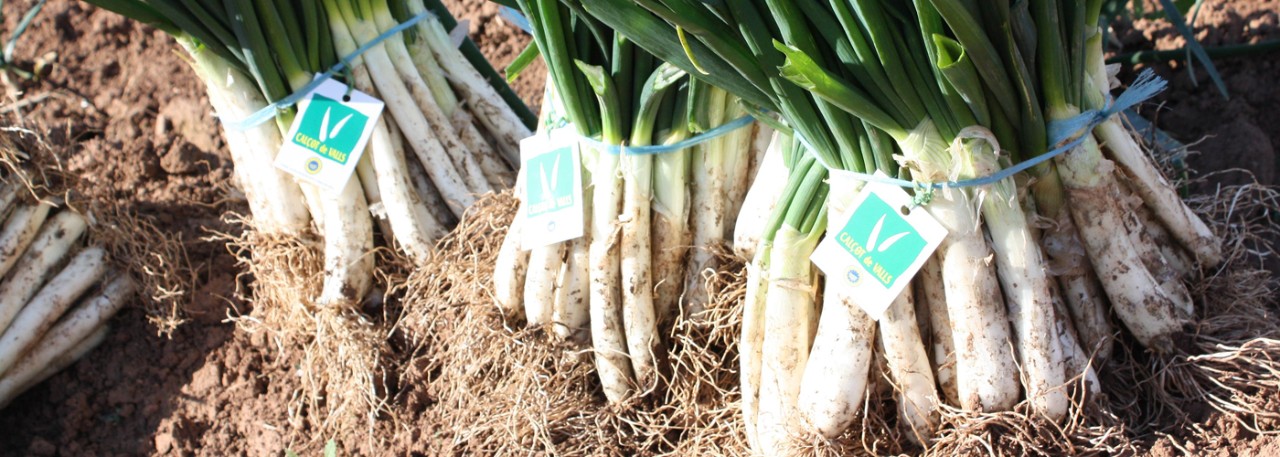.png.transform/rendition-xs/image_image%20(1).png)
Calçot de Valls PGI
Calçots, a type of scallion, are shoots from a fully-developed white onion that have been replanted. As they grow, the plants are earthed up to blanch the base, the part that is eaten. The PGI calçots come exclusively from shoots of Allium bulbs, the variety being Blanca Grande Tardía de Lérida.
Tasting notes
The blanched part is very tender and has a characteristic flavor and sweetness. The stem is a bright white color, is firm and does not form threads when eaten at the right degree of sweetness. As the season passes, the calçots become firmer and reduce their moisture content, taking on a more intense flavor.
Other notes
They should measure 15 to 25 cm long and have a diameter of 1.7 to 2.5 cm. They are sold in labeled bundles of 25 or 50 stems.
Production / Processing method
Plant density for the onions is approximately 0.5 x 0.3 m, and 4-7 calçots are obtained from each bulb. The growing process begins when the white onion seeds are sown – in October, November and December. Once the seed has germinated and grown sufficiently, the shoots are planted out. When the head appears as with a normal onion, usually in early summer, the shoots are again removed. The top is cut off and the scallions are kept for a few weeks then replanted, but only half buried with the white top visible. As soon as the shoots begin to grow, earth is piled up around them to blanch them. This operation is repeated two or three times as the shoots grow to the required size. It takes one year to produce a calçot.
Harvesting takes place when the shoots from the bulb are mature. It must be done very fast and carefully to guarantee product and keeping quality. Once they have been removed from the earth, the shoots are individually separated from the plant. They then undergo the following processes:
- Classification into even batches to meet different demands.
- External quality control to ensure the bundles contain the correct number of stems, and that there are no defects or foreign matter.
- Packing in bundles of 25 or 50 stems, and tying with the PGI blue band.
- Labeling with the PGI logotype and numbering.
Geography / Relief and climate
The farming soils in the production area mostly lie on calcareous bedrock. In many cases, the soils are deep but incipient, carbonated and with low organic content. The surface horizon is ochreous, and the deep horizon indicates moderately altered, poorly developed soil. This crop needs water so it is often grown on alluvial soil near river beds where the soil is deeper and richer in organic matter.
The production area lies along a coastal strip that runs right through the province of Tarragona from north to south. The climate is maritime Mediterranean, with mild temperatures, the average annual temperature being 16ºC. Nine months of the year are frost-free. Average annual rainfall is 576 mm, reaching a maximum level in autumn with another peak in spring. The most limiting climate factor for this crop is the frost-free period as it cannot grow in areas with frequent frosts.
Regulatory Council
Consejo Regulador de la IGP Calçot de Valls
Muralla de Sant Antoni, 8, dpcho. 5
43800 Valls (Tarragona)
Tel: (+34) 977 609 083
info@igpcalcotdevalls.cat
www.igpcalcotdevalls.cat/
Sources:
The calçots are sold in labeled bundles of 25 or 50 stems.


- /content/dam/en/icex-foodswines/images/products/fruits---vegetables/calçot-de-valls-pgi/Calçot%20de%20Valls%20PGI%20carr1.jpg
- /content/dam/en/icex-foodswines/images/products/fruits---vegetables/calçot-de-valls-pgi/Calçot%20de%20Valls%20PGI%20carr2.jpg

Valls (Catalonia)
